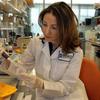Dolphin skin has long inspired research on drag reduction mechanisms due to the presence of skin ridges that could reduce fluid resistance. PhD candidate Dylan Wainwright and Prof. George Lauder collected in vivo three-dimensional surface data on the skin from five species of odontocetes (cetaceans that includes dolphins, porpoises, and all other whales possessing teeth) to quantitatively examine skin texture, including the presence and size of ridges.
Wainwright, Lauder and team molded the skin of live dolphins to study the texture of their skin and how it might relate...
Read more about How Smooth Is A Dolphin?









